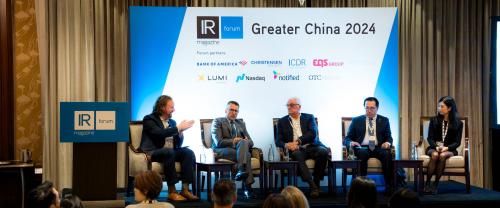Seven things you should know about conferencing
1. Companies that miss expectations by just one cent have quarterly conference calls that are 1.1 minutes longer than those that meet expectations, according to researchers at Stanford University. The average call lasts 51 minutes.
2. It is becoming much, much harder to lie. Detecting deceptive rhetoric in earnings conference calls has turned into a vital cottage industry in finance and accounting, as well as in linguistic, vocal and other research. Even ex-CIA agents, skilled in this sort of thing, have joined the party, working with hedge funds to uncover smooth corporate talkers.
Boston-based Business Intelligence Advisors (BIA) promises investors behavioral analysis designed to ‘fill critical information gaps in an investment thesis or due diligence process’. The company claims it has already analyzed more than 4,000 earnings calls, across more than 1,500 companies in more than 30 countries. The secretive BIA does not give interviews to the press, however. ‘Our posture may change in the coming months,’ divulges a spokesperson.
But there’s no reason to let a little cognitive dissonance spoil your conference call. Obviously, there can be no definitive checklist but, on a linguistic level, certain patterns do emerge. Here’s how to avoid them.
Do use the following words and phrases:
• I am an honest man
• I, me, my
• Specifically, fundamentally
• Solid, respectable
• Good, positive, helpful
Don’t use:
• I am not a crook
• The team, the company
• Generally
• Fantastic, astounding
• As I said before…, as you know..., everybody would agree..., they know...
• Everybody, anybody, nobody, every, all
• Almost, appears
When a couple of Stanford researchers fed almost 30,000 earnings Q&A transcripts into a computer that filtered for keywords flagging deception, they found companies that later significantly restated earnings frequently flubbed linguistic tests.
‘Our model works better than accounting techniques that use discretionary accruals to detect deceit,’ explains study co-author Anastasia Zakolyukina, a PhD candidate at the Stanford Graduate School of Business.
‘When under stress, people tend to make different word choices and so give themselves away. Of course, some are better at lying than others.’
3. The new high-definition video world may be too revealing for some, but that’s just fine with Tim Duffy, chief executive of fast-growing conferencing provider MeetingZone. Once a big noise at video conferencing giant PictureTel, Duffy has converted to an audio philosophy.
‘Investor relations calls use a rich mix of media to tell a story but audio is the basic common denominator,’ he points out. ‘Once you step away from that, you start to get more complicated and filter your audience. And the more complexity, the more setup time – which analysts don’t have.’
This generation of analysts may not have the time, but the next generation cometh, and technologies like video conferencing are second nature to the digital crowd. With more infrastructure in place to support high-quality calls, this ‘market awareness’ will drive video conferencing in the next five years, according to a report by telecommunications advisory firm IDC.
One fast-growing web-based video conferencing service is New York-based ooVoo, which is targeting business users and looking to pre-load its technology on handsets. Count on video conferencing becoming a part of everyday life.
4. Conference calls tend to be associated with better market reactions to corporate merger announcements. Researchers from Penn State and the University of Maryland suggest that this is because conference calls provide more forward-looking details than mere press releases.
The researchers also find bidders more likely to hold conference calls when making big plays and paying with lots of stock.
‘We have recently seen an increase in demand for our combined audio, web conferencing and webcasts solutions for corporate communications announcements,’ comments Gregory Batchelor, director of EMEA marketing at Arkadin, a provider of conferencing solutions. ‘Our clients tell us that combining these announcements with a visual element makes more impact than a simple quarterly conference call.’
5. Arguments persist both for and against providing earnings guidance. A recent study published in Contemporary Accounting Research, based in part on conference call data, points to some truisms – and some common misconceptions:
• ‘Poor performance is the most common reason for guidance cessation.’ – True
• ‘Managers, free of investors’ myopic shackles, will invest more money in capital expenditure and R&D.’ – False
• ‘Guidance stoppers tend to increase disclosure of alternative, forward-looking information.’ – False
• ‘Analyst coverage usually decreases following guidance cessation.’ – True
• ‘Analyst forecast errors and dispersion increase following guidance cessation.’ – True
6. Chief executives with relatively more financial expertise than their CFO – as defined by the amount of Q&A speaking time during conference calls – issue fewer forecasts but of better quality, according to a Duke University study.
7. Research indicates that quarterly call analyst participants are not neutral, but bias their language in order to appease management and their institutional clients – although it’s possible you already knew that.










